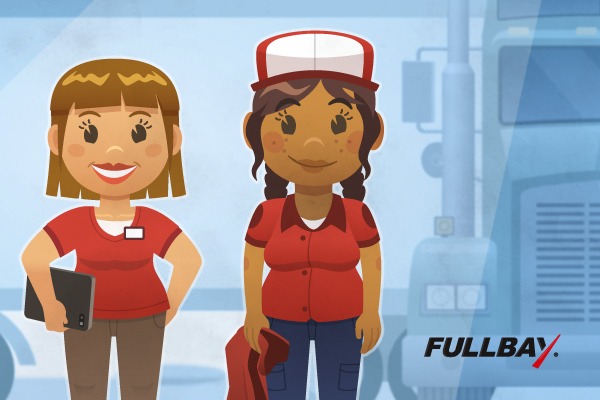Women in Trucking

Ladies, start your engines!
Trucking has long been considered a male domain, requiring long hours, lots of travel, and the occasional interaction with sketchy characters. It’s an interesting job that will take you to cool places – and pays decently, too – but historically it’s been a place for men. You’d find the occasional woman trucker cruising down the highway, but they were few and far between.
That’s changing. Trucking, like many other professions, has crossed into the twenty-first century and slowly opened its doors to female drivers. It’s not easy to become one, and once you’ve got the gig you’ll face challenges, but if you’ve ever dreamed of gunning it down a lonely stretch of highway, here’s what you need to know.
In this post, we’ll take a look at:
- The truck driver shortage
- The scarcity of women in trucking
- Pay for truck drivers
- The positive and negative aspects of being a female trucker
- Comparing the pros against the cons
- How women truckers deal with the negatives
- How to go about getting a CDL
- Looking for driving jobs
Women in the Driver’s Seat
Here’s a secret: women truckers have been around for longer than you think. Not a lot of women truckers…but some. They’ve been out there. The last decade has seen an upswing in the number of women opting to drive a truck. Let’s explore the reasons:
Wanted: Truckers
We’ve talked at length about the diesel mechanic shortage and the efforts being made to fix it.
But there’s a second shortage looming: that of drivers.
Yes, folks, we’re running out of truckers.
The alarm hasn’t rung quite as loudly on this one, possibly because people are pinning their hopes to the self-driving semis that seem to be right around the corner. But the reality is we’re still several years off from completely autonomous trucks, and we still need lots of drivers now. In 2016, there were 36,000 more driving jobs than there were drivers. In 2018, the shortage was reported to be about 63,000. What’s more, an ATA report projects that the problem will worsen. If the freight business continues to grow at the current rate and the trend of older drivers retiring and fewer new drivers coming into the workforce holds, the shortage could reach 175,000 by the year 2024.
The driver shortage has made a number of the old guard who used to be hostile to women drivers relax their views.
New Family Dynamics
Once upon a time…well, OK, not really all that long ago, men were the breadwinners and women stayed home and raised families. That’s just how much of society rolled. Some women had jobs, but they certainly weren’t looking for roles that would take them far from their families, sometimes for days, weeks, or months at a time. As a result, truck driving remained a distinctly male environment for a long time.
These days, men play a larger role in caring for and raising families. What’s more, women are having fewer babies, or putting off starting a family. Around 40 percent of workers in the U.S. are female.
With that said, it’s estimated that only about 6 percent of truckers are women.
Why Get Into Trucking?
All right, ladies, here’s the scoop.
Pay
First, some primary information: Trucking is currently one of the highest-paying jobs that doesn’t require a degree. If college isn’t on your radar, you don’t need to worry – the Bureau of Labor Statistics reports the median salary for truckers at $43,680. Some industry numbers say that average is around $53,000, so your mileage may vary (pun intended).
How are drivers paid? Let us count the ways. Some drivers are paid hourly and some owner-operators charge a percentage of the revenue from the load. What’s more, to attract drivers, some fleets offer per diem pay to cover expenses drivers incur on the road, like meals. Other types of pay that can pad a driver’s paycheck include:
- Accessorial Pay: Compensation for services other than driving, such as after-hours or non-dock deliveries, applying shrink wrap to pallets, loading and/or unloading freight, and more.
- Detention Pay: Compensation for time lost if the shipper unnecessarily delays the pick-up.
- Stop Pay: Compensation for multiple stops between picking up the load and dropping it off. This pay only kicks in if the type of load dictates a lot of stops must be made, and it doesn’t usually include the pick-up or destination locations.
Additionally, many fleets provide signing, safety, efficiency, and fuel bonuses, along with benefits packages and scheduling/route flexibility.
A word of warning: Many truckers still get paid by the mile, and that rate is typically cents per mile, not dollars. It runs between .28 and .40 cents/mile, but if a driver makes good time, that could still work out to fairly good hourly pay. It’s unforeseen delays that whittle the paycheck down. The more time wasted stuck in traffic or waiting to pick up a load, the less you’ll make. Before signing on with anyone, find out how you’ll be paid.
Life as a Trucker
So, what’s it like being a female truck driver?
Any job comes with perks and drawbacks, so let’s go over a few of those here.
Trucking is one of the few businesses that truly offers equal pay for equal work. If you’re willing to drive the miles and do the job, gender doesn’t matter. Additionally, real-life women in trucking say they like working the open road instead of spending their time indoors behind a desk. If you’re a self-motivated woman who likes driving and who is looking for a job that offers flexibility along with good pay and great benefits, driving a truck might be exactly the thing.
(Plus, you get to say, “I drive a truck” when people ask what you do, which is pretty awesome.)
Unfortunately, trucking comes with its share of drawbacks. The food on long hauls isn’t great for you, especially if you wind up hitting up diners and drive-throughs.
We’d be making a blatant omission if we didn’t touch on problems women have in just about any industry. Yes, there’s sexism, harassment, and intimidation out there – unfortunately, even when you drive a big rig.
Drive Healthy, Drive Safe
- Plan your route ahead of time. There’s no way around it – you’ll have to stay in some less-than-stellar truck stops now and then. But a clear idea of where you’re going will let you pick out the areas you want to stop in.
- Check out reviews. You’ll want to know what others think of the restrooms, showers, and eating options.
- Always lock your doors. Even if you’re just stepping outside for a breather, lock them.
- Stay in or near lighted areas as much as possible. We think this is general common sense, but it bears repeating. Stay in the light!
- Make your own meals. You’re not confined to the lumberjack slam at Denny’s (delicious as it is) or whatever biscuit sandwich you can scrape up from the nearest fast food joint. A lot of the newer sleeper cabs have room and hookups for at least a minifridge. Some companies furnish their trucks with a microwave. If all else fails, you can bring a cooler. The point is you’re not limited to only the food you find on the road!
- Join a women’s organization. Check out the Women in Trucking Association. They can offer advice, support, and valuable resources.
For many, the pros outweigh the cons, and not all women experience the worst of the downside. Some female drivers say they experienced no problems during training and found jobs working for fleets that respect them as drivers without taking gender into account. In their interactions with fellow drivers, specifically men, they report other truckers to be pleasant and helpful.
Those accounts prove it’s possible to avoid the darkest of the dark side of trucking. Being a female truck driver, you need to make smart choices, including:
- Where you get your training
- The company you drive for
- Where you stop for fuel, food, and rest
- Who you let into your truck
How to Get Started
It does cost money to get your commercial driver’s license (CDL), but you shouldn’t go into massive debt to do it. The price of CDL training should be between $3,000 and $7,000. Avoid schools that charge more than that, as well as ones that suggest high-interest loans or mortgaging your house to pay tuition. Some trucking companies offer training and a guaranteed job after you get your license that sets you up to pay back the schooling costs. Some of those offers are legitimate, but some aren’t. Do your homework and track down the reputable ones. You’ll likely have to agree to work for the company for a certain amount of time after getting your license, and you’ll want to make sure the payments they’ll take out of your check will leave enough for you to live on.
Alternatively, not many people realize that grants and scholarships are available to pay for trucking school. What’s more, veterans have access to education benefits they can use to pay for CDL training. All of these options will get you a CDL without having to pay for it yourself.
Another thing to consider when looking for a school is to find one that provides more than a 3 or 4-week crash-course (no pun intended). The training should include both study time in a classroom setting as well as hands-on training in a truck. Local community colleges typically have good programs with professional instructors. Wherever you end up going, research the school/program to find out what kind of reputation it has.
Finding a Job
Congratulations! You’ve got your CDL and you’re ready to get a job and hit the road.
When you find a company you like and go through the interview process, make sure you understand your job description, how tight or flexible the delivery schedules are, and how much you’ll actually be paid. Talk about hypothetical scenarios to see how they’ll affect your employment. Those could be things like delays due to bad weather and traffic or family issues that require time off. As with any employment interview, bring up the questions or concerns you have before you take the job.
You may also want to investigate the company and learn about their policy on sexual harassment, as well as how they’ve handled any past claims of it.
Get Driving
More and more women are climbing up into big rigs and heading out onto the highway. Despite some of the cautionary chatter above, it’s actually a great time for women to get into trucking. The industry has opened up more than ever before, and many companies are actively trying to make the gig more appealing to women. A skilled and reliable driver can command high pay, a flexible schedule, and job security – things people want no matter what their gender. If you’ve got a hankering to hit the road, don’t sit here and wait for us to chatter at you more. Get out there and start trucking!
With additional contributions/reporting from Lisa

